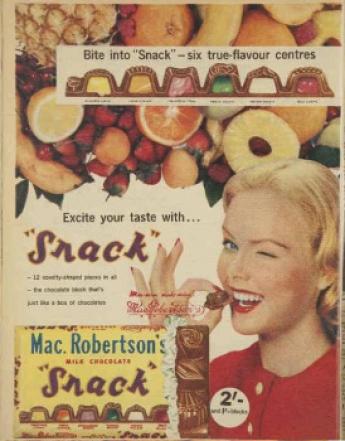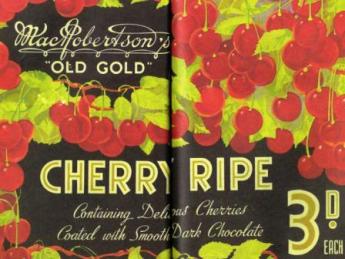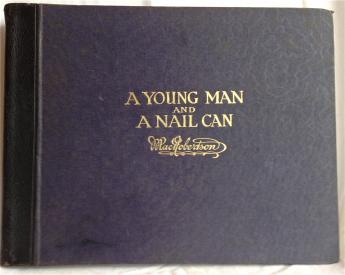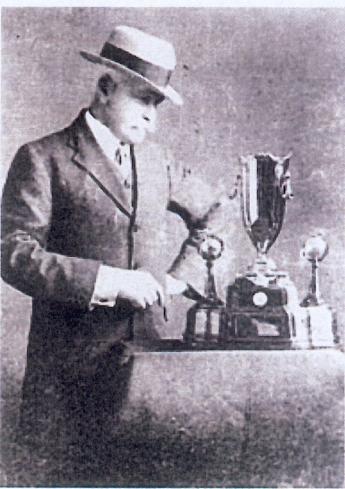Australias Willy Wonka: From Home Candy-Making to Confectionery Magnate

By Kristin Masters
The man who introduced chewing gum to Australia came from much humbler beginnings. Macpherson Robertson, founder of MacRobertson’s Steam Confectionery Works, is known for building a true candy empire. An innovative marketer, Robertson published a book about his rise to success. The copiously illustrated volume, entitled A Young Man and a Nail Can, romanticizes Robertson’s rags-to-riches story and offers a glimpse into the world of an ingenious businessman who forever changed the world of confections.
The oldest of seven children, Macpherson Robertson was born on September 6, 1859 in Ballarat, Victoria. His father, a Scotsman, moved between jobs as a carpenter and gold miner; he sent his family to Scotland in 1869 and went to Fiji. The family reunited five years later in Melbourne. That same year, Macpherson (who went by Mac) took an apprenticeship at the Victoria Confectionery Company. This would be the first of several such positions, and by 1880 Robertson had learned enough to start making his own sweets. He used the family bathroom as his kitchen and sold his wares to local shop owners.
Robertson’s venture grew more quickly than he expected. Soon other members of the family had begun working with him, and by the late 1880′s MacRobertson’s Steam Confectionery Company had over 30 employees. Robertson left the company for a few years after his marriage to Elizabeth Hedington (8 July 1886) caused a family dispute. But the company foundered without Roberson, and he returned. Robertson’s unique brand of innovation, promotion, and packaging fostered incredible growth for MacRobertson’s.
Robertson introduced Australia to both chewing gum and fairy floss. He promoted Pepsum gum among prominent athletes and his own cycling club. He also created incentives for his employees and customers to share ideas for candy-wrapper designs, advertising slogans, and “conversation lolly” messages. Robertson was also the mastermind behind the “Old Gold” line of exclusive chocolates. Soon MacRobertson’s was the largest confectionery works in Australia, edging out the English importers who’d had a monopoly on the business for generations.
While Roald Dahl’s Willy Wonka has a mythical factory, Robertson built the “Great White City.” All the factory buildings were painted bright white, and all employees wore crisp white uniforms. The MacRobertson’s delivery trucks were pulled by prize grey draught horses. He lent out the horses for public functions and drove them himself on Eight Hours Day.
When A Young Man and a Nail Can was published in 1921, Robertson promoted the book enthusiastically. The tale gave Melbourne its own Dick Whittington legend and made Robertson an even more legendary figure in the city. Already, he had won the people’s loyalty with his support of labor unions and generous welfare provisions. Robertson also encouraged the Female Confectioners’ Union.
In 1926, the English confectionery firms Cadbury, Fry, and Pascall merged and began manufacturing in Tasmania. Robertson responded by expanding MacRobertson’s product line and doubling his promotion efforts. He continued to find creative ways to promote the company; in 1928, for instance, Robertson joined renowned aviator Horrie Miller in MacRoberston Miller Aviation Company, Adelaide. They financed the MacRobertson Round Australia motor truck expedition.
For the next few decades, Robertson continued to garner goodwill as a philanthropist. By 1933, he’d given away over £360,000, part of which went to fund British, Australian, and New Zealander expeditions to Antarctica. He remained at MacRobertson’s helm until his death on August 20, 1945. Family members managed the company for several more years before selling it to Cadbury-Schwepps in 1967.
The story of Mac Robertson as told in A Young Man and a Nail Can captures Robertson’s inspiring entrepreneurship and reminds us of the golden age of confectionery. A delightful and rare book, it gives us an inside look at iconic sweets of Australia – and the iconic man behind them.
(Posted on Lizzyoung Bookseller.com, the blog and website of Elizabeth Young, antiquarian bookseller specializing in anything and everything associated with the wonderful world of food and drink. Presented here by permission of Elizabeth Young and Kristin Masters.)
Melbourne Rare Book Week - July 18 to 28, 2013, incorporating ANZAAB’s 40th Australian Antiquarian Book Fair



